The Latest from Boing Boing |  |
- SPIDER surgical instrument looks like a proto-bush-robot
- Old film rejection slip: "All scenes of an unpleasant nature should be eliminated"
- Baby in a watermelon eating a watermelon
- The New York Times Torture Euphemism Generator!
- Van Gogh's Ear cat toy
- WSJ: Myspace.com and Myspace apps leak user data
- Wikileaks hacked by "very skilled hackers" ahead of Iraq War Logs release
- Wikileaks releases nearly 400,000 new secret Iraq docs, with help from news orgs
- Crazy jihad troll who threatened Matt & Trey from South Park is so totally busted
- Pumpkin Pi
- The Rudy Coby Experiment at The El Rey Theatre on 10/23/10
- Hakuba Camera Neck Strap
- The Candy Hierarchy
- "Should Be Legalized" Eminem - Love The Way You Lie parody
- Smigly Cartoon: noise
- Google shelters profits overseas to keep corporate tax rate at 2.4 percent
- Crocodiles on planes prove greater threat than Muslims
- New Keith Morris video: "I Don't Belong"
- US Air Force Academy: We are ready for The Witches (The Gays, not so much)
- Chris Berens new dreamlike paintings on photo paper
- Erik Davis on American hoodoo
- LIFE magazine on "LSD Art," 1966
- The cartoons of Abner Dean
- The last mystery of the blues: were Robert Johnson's recordings sped up?
- Timothy Leary's 90th birthday today
- Sears reaches out to neglected Zombie-American demographic
- Year's Best Tech Writing 2010
- Amazing footage of next generation prosthetic arm
- HOWTO make a trashcan Stormtrooper helmet
- Author: 4chan bootlegging led to big sales increase
| SPIDER surgical instrument looks like a proto-bush-robot Posted: 23 Oct 2010 01:17 AM PDT The TransEnterix SPIDER Surgical System is a laporoscopic surgical instrument that allows for easy tool-swapping without withdrawing the device from the patient. It also happens to look like a distant ancestor to Moravec's bush robot.
TransEnterix SPIDER Surgical System Gets CE Mark |
| Old film rejection slip: "All scenes of an unpleasant nature should be eliminated" Posted: 23 Oct 2010 01:12 AM PDT 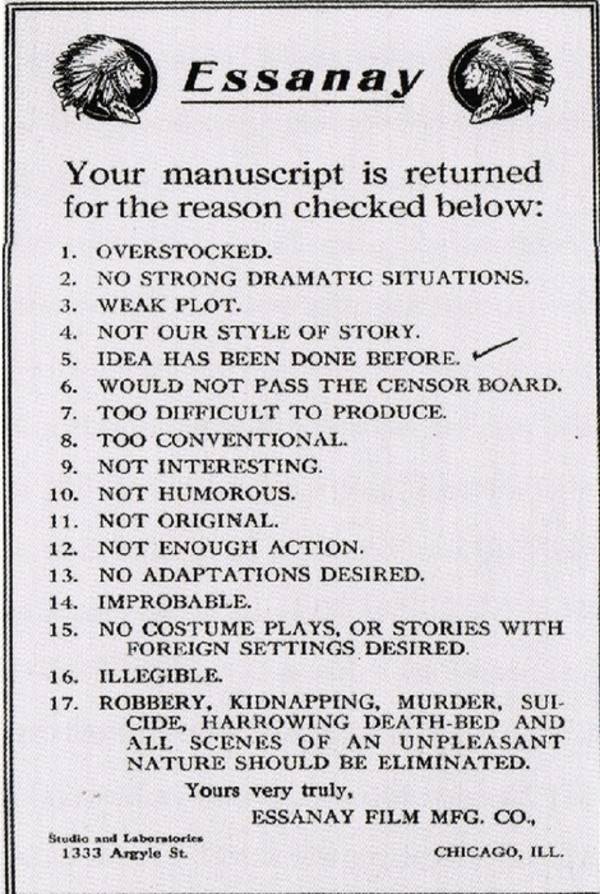 This undated form rejection from Essanay Film Manufacturing Company (which was in existence from 1907-1925) is a sweet little snapshot into the mores of the time -- and the bits that haven't changed since. According to the Old Hollywood Tumblr, "[Essnay is] mostly remembered today for its series of Charlie Chaplin films." Rejection slip, Essanay Film Manufacturing Company (via Neatorama) |
| Baby in a watermelon eating a watermelon Posted: 22 Oct 2010 09:05 PM PDT Video Link. Consider it a cute-chaser with which to wash away the entire week. |
| The New York Times Torture Euphemism Generator! Posted: 22 Oct 2010 07:51 PM PDT Reading the NYT's stories about the Iraq War logs, I was struck by how it could get through such gruesome descriptions — fingers chopped off, chemicals splashed on prisoners — without using the word 'torture.' For some reason the word is unavailable when it is literally meaningful, yet is readily tossed around for laughs in contexts where it means nothing at all. It turns out the NYT has a reputation for studiously avoiding the word, to the point of using bizarre bureaucratic alternatives. It must be awfully hard work inventing these things. So I thought I'd help out by putting together a torture euphemism generator that the New York Times' reporters can use to help avoid the T-word in their thumb removal and acid bath coverage.
Click the "new headline" link to get a new one! (It won't refresh the ads or anything.) |
| Posted: 22 Oct 2010 07:49 PM PDT 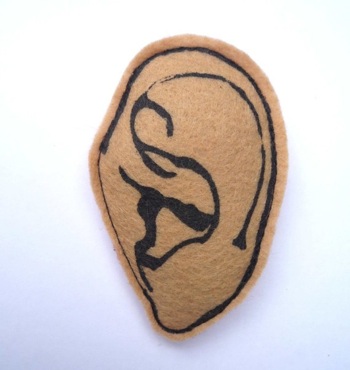 What the hell is that, you ask? Why, it's Van Gogh's Ear. Specifically, it's a Van Gogh's Ear organic catnip cat toy. Seriously. It's for sale at The Modern Dog, a Venice, California pet boutique owned by my dear friends Guy Miracle and Lance Castro. Also available in a similarly strange vein is a catnip toy emblazoned with, er, Michael Jackson's face. You can also get them for $8 and $9, respectively, from the Modern Dog's online shop. What the hell is that, you ask? Why, it's Van Gogh's Ear. Specifically, it's a Van Gogh's Ear organic catnip cat toy. Seriously. It's for sale at The Modern Dog, a Venice, California pet boutique owned by my dear friends Guy Miracle and Lance Castro. Also available in a similarly strange vein is a catnip toy emblazoned with, er, Michael Jackson's face. You can also get them for $8 and $9, respectively, from the Modern Dog's online shop. |
| WSJ: Myspace.com and Myspace apps leak user data Posted: 22 Oct 2010 03:56 PM PDT The Wall Street Journal reports that MySpace.com and some popular MySpace applications transmit data to outside advertising companies that could be used to identify users. |
| Wikileaks hacked by "very skilled hackers" ahead of Iraq War Logs release Posted: 22 Oct 2010 03:51 PM PDT Forbes reports that Wikileaks suffered its first major security breach in history on Wednesday, just days before today's release of the Iraq War Logs. |
| Wikileaks releases nearly 400,000 new secret Iraq docs, with help from news orgs Posted: 22 Oct 2010 04:14 PM PDT  IMAGE: Each death noted in the Iraq war logs released today by Wikileaks is mapped with Google Maps, by the Guardian.
Wikileaks has just published The Iraq War Logs, described as "the largest classified military leak in history."
The 391,832 reports document the war and occupation in Iraq, from 1st January 2004 to 31st December 2009 (except for the months of May 2004 and March 2009) as told by soldiers in the United States Army. Each is a 'SIGACT' or Significant Action in the war. They detail events as seen and heard by the US military troops on the ground in Iraq and are the first real glimpse into the secret history of the war that the United States government has been privy to throughout. The reports detail 109,032 deaths in Iraq, comprised of 66,081 'civilians'; 23,984 'enemy' (those labeled as insurgents); 15,196 'host nation' (Iraqi government forces) and 3,771 'friendly' (coalition forces). The majority of the deaths (66,000, over 60%) of these are civilian deaths.That is 31 civilians dying every day during the six year period. The Guardian is among the first news orgs to publish analysis, and leads with the statement that the files show how the US turned a blind eye to torture in Iraq, and "expose serial abuse of detainees, 15,000 previously unknown deaths, and a full toll of Iraq's five years of carnage." The archive is alleged to have been sourced from Pfc. Bradley Manning, the same US army intelligence analyst who is believed to have also leaked a smaller cache of 90,000 logs chronicling incidents in the Afghan war. According to the Guardian's early analysis, the new logs detail how:
Guardian's full coverage here, with an infographic mapping every death here. As of 1:46pm PT, Al Jazeera's coverage is live online and on-air. Here is their inforgraphic/data-mapping effort. A statement regarding redactions ends with an indication of which other news orgs were granted early access by Assange: "But working alongside the New York Times, The Guardian, Der Spiegel, and the UK's Channel 4 TV, Al Jazeera is clear that releasing the Iraq files - despite their secret nature - is vital to the public interest." In a tweet posted around 145pm PT today, @wikileaks (presumably Julian Assange) wrote, "Al Jazeera have broken our embargo by 30 minutes. We release everyone from their Iraq War Logs embargoes." So, which other news organizations had embargoed access to the documents? Again, from @wikileaks: "TBIJ, IBC, Guardian, Spiegel, NYT, Le Monde, Al Jazeera, Chan4, SVT, CNN, BBC and more in the next few hours. We maximise impact."
A close analysis of the 391,832 documents helps illuminate several important aspects of this war:
Update, 414pm PT: Wired News analysis is here.
|
| Crazy jihad troll who threatened Matt & Trey from South Park is so totally busted Posted: 22 Oct 2010 03:12 PM PDT  A 20-year old guy named Zachary Adam Chesser pled guilty on Wednesday to three federal charges: communicating threats against South Park's writers, soliciting violent jihadists to desensitize law enforcement, and attempting to provide material support to Al-Shabaab, an organization designated by the US as a terrorist group. Chesser is so busted. He faces a maximum penalty of 30 years in prison when sentenced on February 25, 2011. He was born Jewish, and converted in his teens to an extremist strain of Islam, adopting the name Abu Talhah al-Amrikee. Above, from left to right, his high school yearbook photo; a pic in the school paper about his mad breakdancing skills, and Chesser transformed into Abu Talhah al-Amrikee: a violent fundamentalist who will likely spend the next three decades in prison.
Read the Department of Justice press release:
|
| Posted: 22 Oct 2010 01:35 PM PDT "Pumpkin π," carved and photographed by Alex Gleeson. Click to embiggen. |
| The Rudy Coby Experiment at The El Rey Theatre on 10/23/10 Posted: 22 Oct 2010 12:53 PM PDT  The amazing magician Rudy Coby is performing at the El Rey Theatre in LA on Saturday 10/23/10. I've seen him do his wildly inventive show at the Magic Castle and at Dr. Sketchy's and he is outstanding. The amazing magician Rudy Coby is performing at the El Rey Theatre in LA on Saturday 10/23/10. I've seen him do his wildly inventive show at the Magic Castle and at Dr. Sketchy's and he is outstanding. He's also producing an event that will run for a week at The Magic Castle from Oct. 25 through Oct. 31, called Mr. Dead's Underground. |
| Posted: 22 Oct 2010 01:52 PM PDT  Most compact digital cameras come with a lousy wrist strap. I say "lousy" because they often lack a slider to fit them to your wrist (which makes them more prone to fall off). And in any case you can't put them around your neck, which is often a better choice if you need both of your hands when you're out and about. That's why I've replaced those straps on my compact cameras with this Hakuba neck strap. I first found one about six years ago when I nearly smashed my Nikon CoolPix 880 on rocks while on a hike with my newly wedded wife in the Virgin Islands. The strap is thick nylon which feels sturdy around your neck. Wearing the camera around your neck gives you both hands free to hold onto rocks or your spouse (hey, we were newlyweds then!). It also has a slider so that you can turn it into a wrist strap (albeit a long one) when you don't want to look like a dork with a camera around your neck, and it has a quick release for when you need to quickly detach it from the strap. There are other straps that might be OK, but I like the durability of the Hakuba strap. -- Ben Rothfeld Hakuba Digital Camera Neck Strap $6 Available from B&H Comment on this at Cool Tools. Or, submit a tool! |
| Posted: 22 Oct 2010 12:16 PM PDT  With Halloween approaching, I thought it would be amusing to write a bit about candy, or more specifically, a system that aims to rank it. In this case, the rubric would be according to "emotional zeal" or something more jargony sounding like "joy induction." Anyway, this hierarchy is the work of a friend and colleague, Ben Cohen. Ben is an environmental historian over at the University of Virginia, but in a previous life, he and I use to write on a blog together. This partnership happened because of our backgrounds publishing science humour (see Ben's clip list here), so in some respects, this "Candy Hierarchy" is just another creative juncture. However, since I'm loving how you can get immediate feedback from the Boing Boing community, I'm also thinking that we could use this opportunity to throw a little kickass "peer review" into the ranking. Kickass because: (1) I know some people are going to be deeply offended by the rankings; (2) the rankings were last updated in 2008, and are therefore long overdue for some revision; and (3) well, isn't peer review just kickass anyway? Oh yeah - the graphic is new (just made it today): hopefully if you play in the comments, some of us can use it one day as a slide for an interesting discussion on the scientific method - yes? Anyway, read on... With Halloween approaching, I thought it would be amusing to write a bit about candy, or more specifically, a system that aims to rank it. In this case, the rubric would be according to "emotional zeal" or something more jargony sounding like "joy induction." Anyway, this hierarchy is the work of a friend and colleague, Ben Cohen. Ben is an environmental historian over at the University of Virginia, but in a previous life, he and I use to write on a blog together. This partnership happened because of our backgrounds publishing science humour (see Ben's clip list here), so in some respects, this "Candy Hierarchy" is just another creative juncture. However, since I'm loving how you can get immediate feedback from the Boing Boing community, I'm also thinking that we could use this opportunity to throw a little kickass "peer review" into the ranking. Kickass because: (1) I know some people are going to be deeply offended by the rankings; (2) the rankings were last updated in 2008, and are therefore long overdue for some revision; and (3) well, isn't peer review just kickass anyway? Oh yeah - the graphic is new (just made it today): hopefully if you play in the comments, some of us can use it one day as a slide for an interesting discussion on the scientific method - yes? Anyway, read on...THE CANDY HIERARCHY Discussion: We place a high value on the peer review process, as past attempts had produced noteworthy relevations, including establishment of reference samples, hereafter termed index candies, as well as the discovery of the importance of caramel in defining the upper tiers. In particular, we hope that some of the new potential advances in the hierarchy will be due to evaluating context setting. For example, rarely in practice do eaters eat just one piece of candy. Evidence indicates that, in general, eaters throw multiple pieces of Halloween candy down their gullets. (When so much is being eaten, research shows the Pelican-gullet-eating-fish imagery is apt.) It thus matters which are eaten earlier and which later. Some tests, for example, indicate that "you can only consume so many premier grade chocolate based candies before you need the zip or zing of a Spree or a Smarty to 'cleanse the pallet'." We also realize that results are predominantly based on North American palates, but hope that the forthcoming discussion will begin to shed light on global preferences. Enough preamble, then. To wit, the Candy Hierarchy (circa 2008): TOP TIER1 (caramel, chewy, oh my classy) Caramellos --- Milky Way --- Snickers --- Rolos2 --- Twix POST-TERTIARY SECOND TIER THIRD TIER BOTTOM TIER Tier so low it does not register on our equipment7 - - - 1. Note that may candies still await placement: York Peppermint Patties, Luna Bars, Reese's Pieces, residue from old paint cans, and Skittles, among others. 2. These may be rolled to a friend. 3. Whoppers blow. 4. Still no unanimous decision on the placement of Candy Corn, which as of 2006 remained unclassified, but as of 2007 had been tentatively placed in the Upper Chewy/Upper Devonian. 2008: no sighting. 5. Unless it's something caramel, pronounced "caramel." 6. Remains an outlier, since it is in no way "chewy." Further studies have not resolved this inconsistency. 7. Yet some would be just as well to be left off. Bit-o-Honey, for example, might be called a lower tier member, but why bother? It says to your trick-or-treaters, "Here, I don't care, just take this." The lesson of Bit-o-Honey is: you lose. Goo Goo clusters, too. You're making a social statement--"I hate you and everything you represent"--when you give these out. |
| "Should Be Legalized" Eminem - Love The Way You Lie parody Posted: 22 Oct 2010 12:01 PM PDT The polls on Prop 19 to legalize pot in California show likely voters to be split down the middle (with a edge toward keeping it illegal). It would be a shame if this chance to end marijuana prohibition is, er, wasted. |
| Posted: 22 Oct 2010 11:46 AM PDT Allen Mezquida writes, animates, and plays the music for his great cartoons, about a sensitive sad sack named Smigly. |
| Google shelters profits overseas to keep corporate tax rate at 2.4 percent Posted: 22 Oct 2010 11:31 AM PDT According to this Bloomberg News piece, Google maintains a complex international financial structure to send most of its overseas profits to tax havens and keep its corporate rate at 2.4%. (Note: I don't use Gmail, G-phone, or Google Docs, but if this were offered as a [legal] cloud service... hell yeah.) |
| Crocodiles on planes prove greater threat than Muslims Posted: 22 Oct 2010 11:34 AM PDT A crocodile stored in a sports bag as carry-on escaped and killed 20 people, passengers and crew, on a flight within the Democratic Republic of Congo. The plane ended up crashing into a house. According to a (human) survivor, "The crocodile survived the blast [before] getting cut up with a machete." More: ABC, Fox, AOL. |
| New Keith Morris video: "I Don't Belong" Posted: 22 Oct 2010 11:19 AM PDT After you enjoy this fantastic Keith Morris (Black Flag, Circle Jerks) video of "I Don't Belong," you can show your love by purchasing his "throbble head" figure.
|
| US Air Force Academy: We are ready for The Witches (The Gays, not so much) Posted: 22 Oct 2010 11:08 AM PDT Noah Shachtman reports on changes at the U.S. Air Force Academy, where Evangelical Christianity was once so dominant that 55 complaints were filed in 4 years alleging discrimination against non-Christians. But... For more on the new, pagan-friendly Air Force, and how earth magick can heal you from "pizza poisoning," go read Noah's piece with the best headline of the week: "Air Force Academy Now Welcomes Spell-Casters." |
| Chris Berens new dreamlike paintings on photo paper Posted: 22 Oct 2010 10:40 AM PDT  Amsterdam painter Chris Berens has a show of new work opening today at Seattle's Roq La Rue Gallery. Above, "Microcosmos," (mixed media on panel, 20" x 20"). Below, "Leap" (mixed media on panel, 18" x 18"). Berens's dreamy images have a decidedly Photoshop feel, but they are not digital. (I can tell by the paint drops?) Indeed, he prefers ink on photo paper to oil on canvas. All of the work is also viewable online. From Roq La Rue: Chris Berens "Leeuwenhart" |
| Posted: 22 Oct 2010 10:22 AM PDT 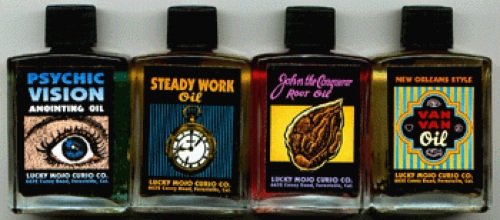 In Erik Davis's latest Pop Arcana column, he looks into American hoodoo and the The Lucky Mojo Curio Co. Occult Shop Catalogue, your one-stop-shop for sachet powders, bottle spells, Cast Off Evil Oil, Money Stay With Me Bath Crystals, and the like. From Erik's essay: "Hoodoo You Know" |
| LIFE magazine on "LSD Art," 1966 Posted: 22 Oct 2010 10:16 AM PDT 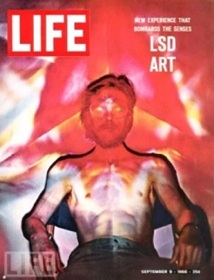  From the LIFE magazine September 9, 1966 cover story about psychedelic art: "Amid throbbing lights, dizzying designs, swirling smells, swelling sounds, the world of art is 'turning on.' It is getting hooked on psychedelic art, the latest, liveliest movement to seethe up from the underground."More LIFE images from that story and the 1960s psychedelic culture |
| Posted: 22 Oct 2010 10:12 AM PDT  "Abner Dean (1910 – 1982), born Abner Epstein, was an American cartoonist who was the nephew of sculptor Jacob Epstein. In allegorical or surrealist situations, Dean often depicted extremes of human behavior amid grim, decaying urban settings or barren landscapes. His artwork prompted Clifton Fadiman to comment, 'His pictures are trick mirrors in which we catch sight of those absurd fragments of ourselves that we never see in the smooth glass of habit.'" What Things Do, Jordan Crane's wonderful online comics site, has large reproductions from Abner Dean's brilliant 1947 book, What Am I Doing Here? |
| The last mystery of the blues: were Robert Johnson's recordings sped up? Posted: 22 Oct 2010 12:56 PM PDT Last time I was here, I speculated on how country blues genius Charley Patton held his guitar. Indeed, I'm a huge fan of pre-war country blues and that led me into an interesting (but failed) project a little while month back. I don't do much magazine work these days (except for the one that pays my mortgage, of course), but I had an idea for a magazine article that wasn't right for HBR. It went a little like this:  Robert Johnson isn't merely the best-known and most popular blues singer ever; he's the performer through whom millions of people have been introduced to the form. For most people who hear Robert Johnson the first time, it's the voice that grabs them. High-pitched, on the edge, filled with authority, lust, and fear, that voice inspired everyone from Eric Clapton and Keith Richards to generations of lesser performers and enthusiasts. There's only one problem: that voice might be a fraud. Robert Johnson isn't merely the best-known and most popular blues singer ever; he's the performer through whom millions of people have been introduced to the form. For most people who hear Robert Johnson the first time, it's the voice that grabs them. High-pitched, on the edge, filled with authority, lust, and fear, that voice inspired everyone from Eric Clapton and Keith Richards to generations of lesser performers and enthusiasts. There's only one problem: that voice might be a fraud. Much of Johnson's life is semi-known and extrapolated (including his tragic death at the age of 27 in 1938), but his recordings and the thick shadow they cast on all blues that followed them were the part everyone could agree on. No more. A group of diehard blues fans are claiming that Johnson's recordings (he was recorded twice; once in San Antonio in 1936, again in Dallas the following year) were sped up as much as 20 percent for release. That speed increase is not enough to rename his signature album Alvin and the Chipmunks Sing the Blues, but it does make one wonder whether one of the most important American musicians of the century is known to us only via some sort of falsifying technical manipulation. The theory, which may have started in Japanese collector circles (it goes back at least to 2002; I'm still hunting for the original source) and has been taken up by several people in the UK, most notably John Gibbens, a poet and musician who has researched the matter and produced alternate versions of the recordings in which he slows down the existing recordings roughly 20 percent. We still hear those amazing words and that tough, doomed voice, but we hear a dramatically different Robert Johnson: his voice sounds more like the masters who preceded him (Charlie Patton, Son House) and his guitar playing, while still intricate (Johnny Shines, another outstanding bluesman who travelled with Johnson for a time, once claimed Johnson used a bizarre seven-string guitar), is more deliberate and dour. He sounds older, nastier, as if the hellhound on his trail that he sang about had caught up to him already. He sounds, in essence, like a different man. Speeding up the recordings, if it happened, changes how we hear blues and rock history. If Gibbens is right, this would change the way we hear and understand the blues. Johnson's raw, on-the-edge voice? Fake. The wild guitar runs that made thousands of aspiring guitarists' fingers bleed? Ditto. Theories abound on why these manipulations might have occurred: It was an equipment failure, perhaps. Some say the recordings had to be sped up to fit on 78-rpm records, which, at the time, had a maximum playing time of three minutes. Others contend it was a conscious decision to make the songs more commercial. Think of the article as CSI: Delta Blues. There's no question that it's possible the recordings were sped up. The performances sound credible at both speeds. The question is whether they were and, if so, how. I'll talk to people who know how records were made in the 1930s (indeed, a few of the people who made them are still with us and I have begun consulting with them) and I will work with original equipment to figure out how it happened (if it happened). I'll take the reader with me as I experiment with a wide variety digital recording and manipulation technologies (both those I can use on my MacBook and those that necessitate a full-fledged recording studio) and learn from the many people who have devoted their lives to blues research to discover more, go deeper, and find the answer. I intend to solve this mystery once and for all, through both audio forensics and old fashioned journalism; this will be a mix of the cutting-edge and the hand-made. Regardless of whether the sped-up theory is true, this is a deep, broad story about how we hear things, how technology, memory, and culture change the way we hear things. Have we, at last, found the first authentic way to listen to the most authentic of American musicians? Or are people just trying to find a new excuse for not being able to play the guy's breakneck guitar parts? That was the pitch. I developed the article with an enormously helpful editor, but the magazine passed on it, in part because it wasn't clear where the story would take me. So before I submitted it elsewhere, I figured I'd do some more research. If I knew for sure that the recordings were altered, I'd have a much stronger pitch. If not ... well, I might not have a story. Good to know that before I promised something to an editor. It was hilarious how quickly the theory fell apart. A quick listen to the recordings of the Light Crust Doughboys, who recorded the same weekend as Johnson in Dallas, reveal no such speed weirdness. And there were some mild fluctuations in tempo that are easily heard in the existing recordings: the version of "Hellhound on My Trail" that came out originally was the off-tune one. Even more damning to the theory, Johnson recorded two versions of "Crossroads," released the faster one, and there's hardly any change in the tone of his voice between takes. Something similar happened with "Stop Breaking Down Blues." There's also the problem that no one who heard Johnson play in real life ever suggested the recordings were sped-up. Johnny Shines told Pete Welding, more than 40 years ago, "most of the time [Johnson] sang in a high-pitched voice." I've got plenty more evidence (Elijah Wald has published a conclusive summary of his own research), but I won't bore you with it. Just because it sounds possible doesn't mean it happened. So why does this theory still float around the Interweb? Because we want a mystery. Like many people who learned about Robert Johnson, I did so as a teenager, a time when boys are particularly susceptible to mythmaking; all that talk of selling his soul to some supernatural entity or another makes the music sound more enticing when you're 14 and looking for a way in. But as we learned more about Johnson from some dogged researchers and developed a more nuanced view of his music and his life, the romantic accoutrements fell off. He was a smart, ambitious man with diverse tastes and extraordinary talents who didn't want to be a sharecropper. The records are amazing, without ridiculous stories that seek to claim a different Johnson for a new generation. That should be enough. The songs still sound great even when someone with a theory plays 'em at the wrong speed. Well, that just shows how great Robert Johnson still is. |
| Timothy Leary's 90th birthday today Posted: 22 Oct 2010 10:28 AM PDT  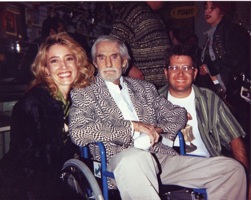 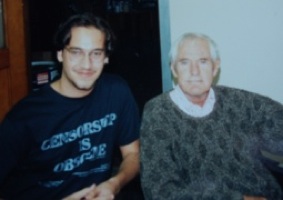 Happy birthday, Tim! We miss you! Top left, a track from "Timothy Leary: You Can Be Anyone This Time Around" (1970) with Stephen Stills (guitar), John Sebastian (guitar), Buddy Miles (drums), and Jimi Hendrix (bass).
Above, Tim with bOING bOING founders Carla Sinclair and Mark Frauenfelder in 1995; and with me in 1991. |
| Sears reaches out to neglected Zombie-American demographic Posted: 22 Oct 2010 09:52 AM PDT  Retailer Sears is focusing a new e-commerce campaign on the underserved needs of the growing Zombie-American community. Site is available in English or Zombian. |
| Posted: 22 Oct 2010 08:53 AM PDT  Julian Dibbell sez, "Did you know there are only 62 shopping days left till Christmas? Yeah, me neither. Good thing Yale University Press has us totally covered on the stocking-stuffer front with THE BEST TECHNOLOGY WRITING 2010, right? Loaded with instant classics no tech-writing connoisseur's bookshelf should be without for even one more agonizing day: Clay Shirky's 'Newspapers and Thinking the Unthinkable,' Kevin Kelly's 'Technophilia,' Steve Silberman's 'The Placebo Problem,' Jill Lepore's 'Baby Food' (on breast-pump technology through the ages), @AstroMike's tweet from space. Plus my own Deep Thoughts on technology, writing, technology writing, et cetera, served up piping hot in the handsome introduction." Julian Dibbell sez, "Did you know there are only 62 shopping days left till Christmas? Yeah, me neither. Good thing Yale University Press has us totally covered on the stocking-stuffer front with THE BEST TECHNOLOGY WRITING 2010, right? Loaded with instant classics no tech-writing connoisseur's bookshelf should be without for even one more agonizing day: Clay Shirky's 'Newspapers and Thinking the Unthinkable,' Kevin Kelly's 'Technophilia,' Steve Silberman's 'The Placebo Problem,' Jill Lepore's 'Baby Food' (on breast-pump technology through the ages), @AstroMike's tweet from space. Plus my own Deep Thoughts on technology, writing, technology writing, et cetera, served up piping hot in the handsome introduction." The Best Technology Writing 2010 (Thanks, Julian!) |
| Amazing footage of next generation prosthetic arm Posted: 22 Oct 2010 08:46 AM PDT Someday, when your estranged father cuts off your hand with a laser knife, the only long-lasting impairments you'll have to deal with will be the psychological ones. In this clip from his new TV show on Planet Green about nifty inventions working their way from the lab to the real world, Dean "Segway" Kamen shows off the Luke Hand—a prosthetic arm that wearers can use like a real arm; controlling it with joysticks in their shoes, and getting feedback about how hard their grip is from a small, vibrating motor. It's a big deal, because it provides a level of small motor skills that hasn't previously been available in prosthetic limbs. Users can pick up objects as small as a chocolate covered coffee bean, or peel a banana without squishing it. The next step, Kamen says, is a prosthetic that's controlled entirely by the mind, just like a real limb would be. Cool stuff! |
| HOWTO make a trashcan Stormtrooper helmet Posted: 22 Oct 2010 08:10 AM PDT  Jason made this nifty trashcan Stormtrooper helmet: "I made this for a helmet for a school event. I had a student that said that he could lend me his costume but at the last minute realised that he no longer had it. In a mad panic I had to create my own. I stumbled upon a little white rubbish bin near my office and it looked kinda head size. The rest was pure inspiration." Make your own Stormtrooper helmet (Thanks, Jason!)
|
| Author: 4chan bootlegging led to big sales increase Posted: 22 Oct 2010 08:09 AM PDT  Legend has it that piracy harms legitimate sales, but the truth is often otherwise. Underground, Steve Lieber's brilliant graphic novel, was recently bootlegged in full at 4chan. Lieber, instead of backtracing the culprits, jumped into the thread and started chatting with his new fans. Later, he posted about the effect the piracy had on his sales. Want to know how big a deal 4chan is? According to Leiber's numbers, the only articles to create clear sales increases of the book were Boing Boing's own review, which wiped out Amazon's inventory, and the 4chan thread. See if you can guess which generated more. [Underground. Submitted by PaulR] Legend has it that piracy harms legitimate sales, but the truth is often otherwise. Underground, Steve Lieber's brilliant graphic novel, was recently bootlegged in full at 4chan. Lieber, instead of backtracing the culprits, jumped into the thread and started chatting with his new fans. Later, he posted about the effect the piracy had on his sales. Want to know how big a deal 4chan is? According to Leiber's numbers, the only articles to create clear sales increases of the book were Boing Boing's own review, which wiped out Amazon's inventory, and the 4chan thread. See if you can guess which generated more. [Underground. Submitted by PaulR] |
| You are subscribed to email updates from Boing Boing To stop receiving these emails, you may unsubscribe now. | Email delivery powered by Google |
| Google Inc., 20 West Kinzie, Chicago IL USA 60610 | |

 Flexible Laparoscopy With The Spider System Is Characterized By:
Flexible Laparoscopy With The Spider System Is Characterized By: 


 This figure capturing Keith in full-on live mode is limited to 1000 numbered units, stands at 7 inches tall, and is made of super strong polyresin.
This figure capturing Keith in full-on live mode is limited to 1000 numbered units, stands at 7 inches tall, and is made of super strong polyresin. 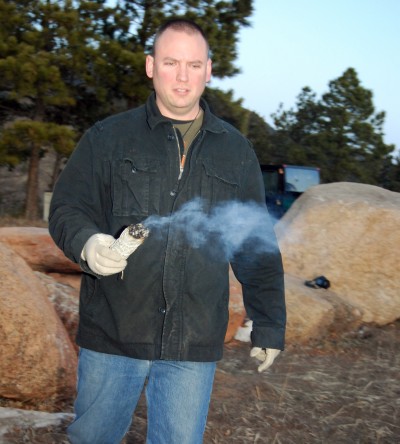
 His work features a fantastical mélange of exotic creatures and 18th century imagery, floating in buttermilk colored clouds, lush verdant countrysides, or silvery sea blues. Photo realistic, totem-like animals and distorted childlike people float like dreams through blurry surrealistic European city scapes or drift on stormy seas on decrepit ships in a soft focus haze, shimmering as if in a fevered dream. It is almost shocking to look at, but in the gentlest of ways. Beyond the wondrous imagery there is another startling and unusual aspect to Chris' work, in which the smooth, translucent look of the his medium of choice (all works are created with drawing ink, bistre, graphite, parquet lacquer, alkyd coating varnish on inkjet photo paper that is then mounted on wooden panels and adhered with bookbinder's glue) is contrasted with fact that the paintings are patch-worked together, in pieces ranging from 1 to 3 inches across. Each section has been been painted numerous times and layered over each other and each segment flows seamlessly into each other, creating a cohesive image...
His work features a fantastical mélange of exotic creatures and 18th century imagery, floating in buttermilk colored clouds, lush verdant countrysides, or silvery sea blues. Photo realistic, totem-like animals and distorted childlike people float like dreams through blurry surrealistic European city scapes or drift on stormy seas on decrepit ships in a soft focus haze, shimmering as if in a fevered dream. It is almost shocking to look at, but in the gentlest of ways. Beyond the wondrous imagery there is another startling and unusual aspect to Chris' work, in which the smooth, translucent look of the his medium of choice (all works are created with drawing ink, bistre, graphite, parquet lacquer, alkyd coating varnish on inkjet photo paper that is then mounted on wooden panels and adhered with bookbinder's glue) is contrasted with fact that the paintings are patch-worked together, in pieces ranging from 1 to 3 inches across. Each section has been been painted numerous times and layered over each other and each segment flows seamlessly into each other, creating a cohesive image...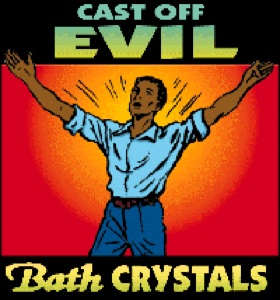 Digging into these pages, one discovers that Lucky Mojo is not New Age nor Neopagan after all, nor does it represent the current of Caribbean religious syncretism that gives us the urban botanicas that in some ways the site recalls. No, Lucky Mojo's magical current is closer to home than any of these, and yet almost invisible.
Digging into these pages, one discovers that Lucky Mojo is not New Age nor Neopagan after all, nor does it represent the current of Caribbean religious syncretism that gives us the urban botanicas that in some ways the site recalls. No, Lucky Mojo's magical current is closer to home than any of these, and yet almost invisible.
No comments:
Post a Comment